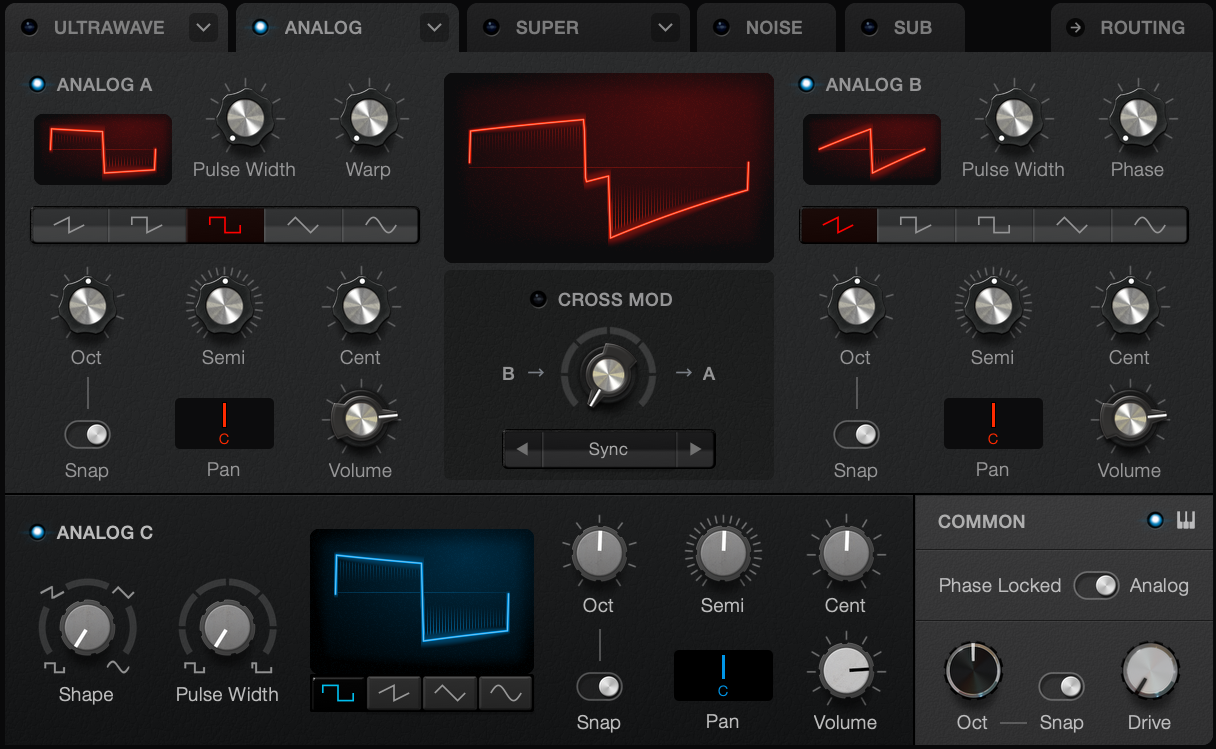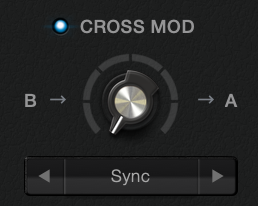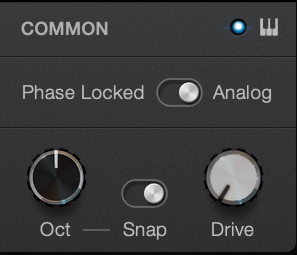Analog Oscillator

This Oscillator type uses analog modelling techniques to replicate the sound of analog synths. It contains 3 Child Oscillators.
Selecting an Analog Osc

You can have up to 3 Analog oscs in your patch, each with and A, B and C osc. Click the arrow button at the right of the first 3 osc tabs, and select Analog.
Analog A and B oscs

- Enabled switch
Turns the Osc on or off - Preview screen
Shows the shape of the current waveform - Pulse Width
Controls the shape of the waveform by skewing it towards the start of the wave - Warp Knob
(Osc A) this control behaves differently for each waveform type. The waveform is altered and made more complex by adding copies of itself or wavefolding. - Phase Knob
(Osc B) controls the starting point of the waveform. Increase the value and look at the small screen to see the current phase.

- Waveform switch
Choose from Saw, SquareSaw, Square, Triangle, Sine

- Oct, Semi, Cent knobs
Control the pitch of the child Oscillator - Octave Snap Button
When enabled, the Oct control will adjust the pitch plus or minus 4 octaves.
When disabled, the control will allow all values within this range. This allows you to automate smooth sweeps of the pitch over large ranges. Perfect for creating kick drums. - Pan
Sets the stereo position. - Volume
Sets the internal level of each child osc. This volume is applied and then the combined signals of the 3 oscs sent to the Analog Osc volume slider in the mixer.
A and B Cross Modulation

The A and B oscs can be synced and modulate / affect each other. The large screen in the center shows the combined result of the A and B oscs, including any Cross modulation
- Cross mod enabled
When turned on, the shape of the osc A waveform will be affected by osc B in a variety of ways. Both A and B oscs need to be enabled. The volume of the B osc is not used, and so can be set to silent and the B osc will still modulate the A osc - Cross mod mode selector
Chooses the mode for the cross modulation - Cross mod amount knob
Controls the amount of the cross modulation.
A and B cross modulation types
Sync

In this mode, whenever the B osc has completed a cycle, the A osc ends abruptly and starts again - it is synced to the B osc. In practice, you will hear differences when the B osc pitch does not match the A osc.
In addition, the amount slider will multiply the pitch used from the B osc. This lets you hear the sync sound without having to change the pitch of the B osc at all.
Sync Log

Similar to sync, but the repeated waveforms get higher and higher in pitch. This sync adds a lot of high frequency harmonics to the osc shape.
FM Exponential

Frequency Modulation. The frequency of the A osc is altered by the waveform of the B osc.
This effect sounds best with the amount knob set to lower values.
FM Linear

Similar to FM exponential, but the relationship between the 2 oscs is calculated in a way that keeps the result more 'in tune' than the Exp mode
AM

Amplitude modulation. The volume of the A waveform is multipled by the B waveform. This mode sounds best when the B osc is set to a lower pitch or octave than the A osc. Similar to ring mod
Analog C

Analog C is similar to A and B, with the following differences
- Shape is a variable control rather than a switch. This lets you use waveforms that are halfway between different shapes.
Common Controls

- Key Follow Switch
When turned on, All 3 oscs will follow the pitch of the notes played on your MIDI keyboard. When disabled, the oscs will play at a consistent pitch - Phase Lock Switch
In an analog synth, the oscillators are always running, whether you are holding down the key or not.
When you play a note, the phase or start position of the waveform could be at any position. Imagine a sine wave - instead of starting at zero and the wave increasing, it could start half way through the shape, essentially making the first part of the cycle sound like a square wave.
In ULTRA, you can choose Phase Locked to force the oscs to reset whenever you play a note.
This might be useful if you are playing a bass sound, and want it to sound exactly the same every time you play a note. - Octave Knob and Snap Switch
Provides an additional control that affects all 3 oscillator pitches.
This is useful if you want to modulate all the oscs at the same time. - Drive Knob
Provides a colourful drive circuit, which affects the sum of the oscs after they have been mixed together.